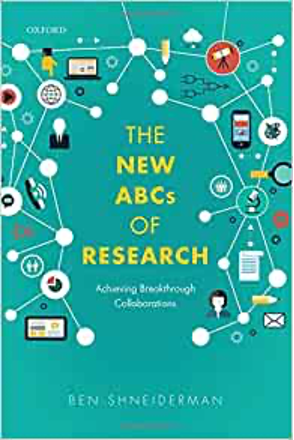On the Horizon: New Communities of Innovation; Billions of Dollars of New Investment
 Seventy-five years ago, Vannevar Bush, an electrical engineer who directed government research during the Second World War, authored Science—The Endless Frontier. His report called for a centralized approach to government research, which led to the creation of the National Science Foundation in 1950 and is credited as a path breaking roadmap for US science policy.
Seventy-five years ago, Vannevar Bush, an electrical engineer who directed government research during the Second World War, authored Science—The Endless Frontier. His report called for a centralized approach to government research, which led to the creation of the National Science Foundation in 1950 and is credited as a path breaking roadmap for US science policy.
Over the next 75 years, the federal government invested billions of dollars of research, creating the world’s leading research universities, while places like Stanford University and state of North Carolina launched research parks; tech transfer programs stimulated by the Bayh-Dole Act flourished; and reforms in SEC regulations created the venture capital sector.
But other countries also made progress in growing their tech-based economies. And a bipartisan awareness grew that something had to be done to improve US competitiveness.
As a result, another “Endless Frontier” is on the horizon. And universities, industry, research parks, innovation districts, economic development officials, cities, states and regions need to prepare.
The Endless Frontier Act, introduced in both the House and Senate last May, is designed to increase investment in discovery, creation and commercialization of critical technologies. The Act proposes spending $100 Billion for strategically advancing science and tech research and development (administered by a renamed National Science and Tech Foundation), and $10 Billion for Regional Tech Hubs to launch new companies, revive American manufacturing and create jobs for local economic impact (administered by the US Department of Commerce). The following are the tech focus areas:
- artificial intelligence and machine learning
- high performance computing, semiconductors and advanced computer hardware
- quantum computing and information systems
- robotics, automation and advanced manufacturing
- natural or anthropogenic disaster prevention
- advanced communications technology
- biotechnology, genomics and synthetic biology
- advanced energy technology
- cybersecurity, data storage and data management technologies
- materials science, engineering and exploration relevant to the other focus areas
The earliest this legislation would likely pass Congress is sometime in 2021. And a worsening economic downturn might make prospects for this initiative unlikely. Regardless, several observers think some version of this bill might pass.
What should universities, industries, cities, states, regions, research parks and innovation districts be doing now to prepare for possible enactment of this measure?
Here are twelve suggestions if you are considering competing for a Regional Tech Hub:
- Do a candid research and tech assessment of your region. Do you have unique capacity in one or more of these areas? Then you should begin to assemble a team to consider competing for one of the regional tech centers. If you don’t have an overwhelming advantage, prepare to go after NSF funding for individual research projects or university research labs in the selected topics.
- The competition for the regional tech centers might make the competition for Amazon HQ2 seem like a game of Tiddlywinks in comparison. The good news? There will be at least 10 centers, probably widely dispersed geographically, so likely many more winners than with Amazon HQ2. Also, plenty of room in the pool for individual funding under the $100M NSF funding as well.

- Because the funding will be for more technology-oriented research, not basic science research, educate yourself on the new ways of applied collaboration for science. A good primer is The ABCs of Research, Achieving Breakthrough Collaborations by UMD professor Ben Shneiderman, a thought leader on highly integrative basic and responsive research theory.
- Don’t go it alone: Not even Stanford or Harvard would likely win a regional tech hub without support from other institutions in their areas. And pick a neutral name, not a single university name, for the regional center to attract other stakeholders and anchor institutions from the area and create a diverse management structure for the center. AURP members University City Science Center in Philadelphia and Research Triangle Park in North Carolina are examples of multi-university stakeholder parks. University City in Pennsylvania even has the state of Delaware as a stakeholder.
- Involve representatives that have applied to the US Economic Development Administration in the past. This is not an R01 application to the NIH. If you don’t know what a local CEDS (Comprehensive Economic Development Strategy) is, make sure you have someone on your team that does.
- Involve tech training centers, community colleges and HBCUs for programming and outreach to the community
- Are you in a federal Opportunity Zone (OZ) that could incentivize private investment in real estate and funding for tech companies? https://opportunitydb.com/location/
- Consider how workforce housing needs, childcare and other facilities will be addressed in your region
- Connect your strategy with your state’s Manufacturing Extension Partnership as advanced manufacturing is an underlying theme of the Endless Frontier Act
- Link programs supporting K-12 education outreach and STEM support to your center.
- Cost share: There is no free lunch and the federal government will require some level of cost sharing for funding of the regional tech HUBs, so a strategy on financing matching funds and in-kind contributions from state, local and private sources needs to be developed.
- Tech hub facility development: Most universities or regions don’t have a lot of unused research or tech development space. It takes a decade or more for most state GO bond (general obligation bond) financed university facilities to be planned, appropriated and built. The use of P3s (public/private partnerships) to build and lease facilities is likely to be needed to compete for these centers on a timely basis. The Association of University Research Parks and its member have nearly 35 years of experience in building communities of innovation across the US and would be a good source of examples and experiences for launching these types of projects. www.aurp.net
A glimpse of how the competition for these centers might be conducted is before us now. The US Economic Development Administration is conducting a $25 million-dollar EDA SPRINT (Scaling Pandemic Resilience through Innovation and Technology) competition.
A webinar on the competition takes place on Oct. 28, 2pm-3pm EDT, with proposal due December 3, 2020.
AURP will host a specific national webinar on how to prepare for the Endless Frontier in the spring 2021. Meanwhile, AURP is hosting its national conference Nov. 2-6, 2020. You can hear from Steve Case of Rise of the Rest; Dr. McMurry-Heath of BIO; a panel on the Bayh Dole Act; representatives from the state of Indiana on how they are bringing their universities together to compete; and many other topics relevant for universities, states, cities, regions and industry planning on competing for Rise of the Rest funding should the federal bill be enacted into law. Continue the discussion on our Blogger.
Information and Registration at https://international.aurp.net/
Hope to see you virtually in November.
Brian Darmody, CEO
Association of University Research Parks
AURP DC Area Office
7761 Diamondback Drive | College Park, MD 20742
[email protected] | www.aurp.net
Brian Darmody is CEO of AURP. Previously he was at UMD in College Park Maryland serving in the legal office, government affairs office, corporate relations and economic development and office of the President. He served in staff roles in US House of Representatives and Maryland General Assembly, as well as with the US Health Care Financing Commission.






















